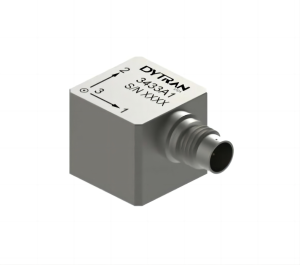
Accelerometers Basics: Understanding the Essentials of Motion Sensing
December 28 2023  1725
1725
Inquiry
Global electronic component supplier AMPHEO PTY LTD: Rich inventory for one-stop shopping. Inquire easily, and receive fast, customized solutions and quotes.
QUICK RFQ
ADD TO RFQ LIST
In this blog, we will delve into the fundamentals of accelerometers, exploring their functionality, types, applications, and significance in modern technology.
What is an Accelerometer?

Types of Accelerometers
- Piezoelectric accelerometers: When an object accelerates, these devices produce an electrical charge using piezoelectric materials.
- Capacitive accelerometers: They use motion-induced changes in capacitance to detect acceleration.
- Piezoresistive accelerometers: These gauge variations in resistance brought on by acceleration using piezoresistive materials.
- MEMS accelerometers: MEMS accelerometers are small mechanical structures that are used by microelectromechanical systems accelerometers to sense acceleration.
- Strain gauge accelerometers: Accelerometers that use strain gauges detect changes in electrical resistance brought on by acceleration to calculate acceleration.
When Were Accelerometers Invented?
Accelerometer technology dates back to the early 20th century, with notable developments taking place in the second half of the century. The 1980s saw the development of microelectromechanical systems (MEMS) technology, which revolutionized the mass manufacturing and shrinking of accelerometers. As a result, accelerometers are now widely used in industrial equipment, car safety systems, and consumer electronics.Video related to Accelerometer
How does an Accelerometer Work?
- The Core Concept:
- Sensing the Deflection:
- Piezoelectric: These sensors work with a substance that, under stress, produces a voltage. A voltage corresponding to the acceleration is produced when the material is squeezed by the spring's deflection.
- Capacitive: The capacitance of the tiny plates inside the sensor varies according to their proximity to one another. The capacitance is impacted and an acceleration measurement is provided by the change in plate spacing caused by spring deflection.
- Piezoresistive: These sensors use materials that, when subjected to pressure, alter electrical resistance. The material is squeezed by spring deflection, which modifies its resistance and indicates the acceleration level.
- Converting the Signal:
- Multi-Axes and Applications:
What Does an Accelerometer Do?
Accelerometers have a wide range of applications, including:- Motion tracking: Accelerometers are used by virtual reality headsets, smartphones, and fitness trackers to measure acceleration forces, track movement, and count steps.
- Navigation: In situations where satellite signals are weak, accelerometers help GPS determine direction and alignment.
- Vehicle stability control: Autonomously changing the brakes and steering to retain control, cars employ accelerometers to detect skids and rollovers.
- Industrial automation: Accelerometers are necessary for balance, navigation, and collision avoidance in robots and drones.
- Medical applications: Accelerometers can follow sleep patterns, identify falls in the older population, and monitor tremors in Parkinson's disease patients.
IMU vs Accelerometer
An Inertial Measurement Unit (IMU) typically consists of multiple sensors, including accelerometers, gyroscopes, and sometimes magnetometers, integrated into a single device. In contrast to an accelerometer, which measures only linear acceleration, an IMU monitors both linear and angular motion more thoroughly. The orientation, velocity, and position of an item in three dimensions can be precisely recorded by an IMU by merging data from several sensors.Can Accelerometers Measure Vibration?
Accelerometers can detect and measure vibration in addition to their primary purpose of measuring accurate acceleration. Accelerometers may measure periodic fluctuations in acceleration, which are a component of oscillatory motion known as vibration. Accelerometers are an invaluable instrument for tracking the health of machinery and structural integrity since they can measure vibration levels by examining the frequency and amplitude of the output signal.Are Accelerometers Accurate?
Accelerometers can provide accurate measurements of acceleration when properly calibrated and utilized within their specified operating conditions. Accelerometer measurement accuracy is affected by various factors, including calibration stability, noise, and sensor resolution. The accuracy and dependability of accelerometers in a variety of applications are enhanced by sophisticated calibration methods, sensor fusion algorithms, and quality control procedures.Where Are Accelerometers Used?
As mentioned earlier, accelerometers are found in a vast array of applications. Here are just a few examples:- Consumer electronics: Consumer electronics include virtual reality headsets, gaming controllers, fitness trackers, smartphones, and smartwatches.
- Transportation: Automobiles, aircraft, drones, and robots.
- Industrial automation: Assembly lines, quality control, and manufacturing robots.
- Healthcare: Fall detection, sleep patterns, and Parkinson's tremor monitoring devices.
- Sports and fitness: Monitoring athlete output and examining gait patterns.
- Space exploration: Navigation and stability of spacecraft, rovers, satellites, and other space exploration tools.
Conclusion
In conclusion, accelerometers are crucial parts of motion-sensing technology that provide insightful information on vibration, acceleration, and orientation for a wide range of applications. They are essential components of industrial machinery, consumer electronics, vehicle safety systems, and aerospace equipment due to their utility, accuracy, and adaptability. Gaining an understanding of accelerometers' principles and applications is essential to maximizing their potential to drive technological innovation and meet changing societal demands.Populer Posts
5SGXEA7N2F40C2G
Intel
LCMXO2-7000ZE-2FTG256I
Lattice Semiconductor Corporation
EP4SE530H40C2N
Intel
EP4CE10E22I7N
Intel
EP4SE360F35I4
Intel
XCV600E-6BG560I
AMD
1ST040EH2F35I2VG
Intel
EP4SE530H35C3G
Intel
AGL030V5-VQ100
Microchip Technology
5CEBA2U15C7N
Intel
EP3CLS70U484C7N
Intel
